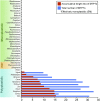Extending the limited transfer window hypothesis to inter-organelle DNA migration
- PMID: 21803764
- PMCID: PMC3163470
- DOI: 10.1093/gbe/evr068
Extending the limited transfer window hypothesis to inter-organelle DNA migration
Abstract
Mitochondrial genomes often contain large amounts of plastid DNA (ptDNA)-derived sequences (MTPTs). It has been suggested that the intercompartmental transfer of ptDNA is greatly reduced in species with only a single plastid per cell (monoplastidic) as compared with those with many plastids per cell (polyplastidic). This hypothesis has not been applied to the movement of DNA from plastids to mitochondria. By analyzing the organelle genomes from diverse mono- and polyplastidic taxa, I show that MTPTs are restricted to the mitochondrial genomes of species with many plastids per cell and are absent from those with one plastid per cell or with monoplastidic meristematic systems. Moreover, the most bloated mitochondrial genomes that were explored had the largest MTPT contents. These data, like previous results on ptDNA-derived sequences in nuclear genomes, support the hypothesis that plastid number and the forces governing the expansion and contraction of noncoding mitochondrial DNA (mtDNA) influence MTPT abundance. I also show that plastid genomes are depauperate in mtDNA-derived sequences (PTMTs), irrespective of the number of mitochondria per cell and plastid genome size, which may reflect the lack of a DNA uptake system in plastids.
Figures


Similar articles
-
Correlation between nuclear plastid DNA abundance and plastid number supports the limited transfer window hypothesis.Genome Biol Evol. 2011;3:365-71. doi: 10.1093/gbe/evr001. Epub 2011 Feb 3. Genome Biol Evol. 2011. PMID: 21292629 Free PMC article.
-
The mitochondrial and plastid genomes of Volvox carteri: bloated molecules rich in repetitive DNA.BMC Genomics. 2009 Mar 26;10:132. doi: 10.1186/1471-2164-10-132. BMC Genomics. 2009. PMID: 19323823 Free PMC article.
-
Twenty-fold difference in evolutionary rates between the mitochondrial and plastid genomes of species with secondary red plastids.J Eukaryot Microbiol. 2012 Mar-Apr;59(2):181-4. doi: 10.1111/j.1550-7408.2011.00601.x. Epub 2012 Jan 11. J Eukaryot Microbiol. 2012. PMID: 22236077
-
DNA transfer from organelles to the nucleus: the idiosyncratic genetics of endosymbiosis.Annu Rev Plant Biol. 2009;60:115-38. doi: 10.1146/annurev.arplant.043008.092119. Annu Rev Plant Biol. 2009. PMID: 19014347 Review.
-
Role of intercompartmental DNA transfer in producing genetic diversity.Int Rev Cell Mol Biol. 2011;291:73-114. doi: 10.1016/B978-0-12-386035-4.00003-3. Int Rev Cell Mol Biol. 2011. PMID: 22017974 Review.
Cited by
-
The complete chloroplast genome of Ginkgo biloba reveals the mechanism of inverted repeat contraction.Genome Biol Evol. 2012;4(3):374-81. doi: 10.1093/gbe/evs021. Epub 2012 Mar 8. Genome Biol Evol. 2012. PMID: 22403032 Free PMC article.
-
Does Cell Size Impact Chloroplast Genome Size?Front Plant Sci. 2017 Dec 14;8:2116. doi: 10.3389/fpls.2017.02116. eCollection 2017. Front Plant Sci. 2017. PMID: 29312382 Free PMC article.
-
Assembly and comparative analysis of the complete mitochondrial genome of Salix wilsonii using PacBio HiFi sequencing.Front Plant Sci. 2022 Nov 16;13:1031769. doi: 10.3389/fpls.2022.1031769. eCollection 2022. Front Plant Sci. 2022. PMID: 36466227 Free PMC article.
-
Assembly and comparative analysis of the first complete mitochondrial genome of Salix psammophila, a good windbreak and sand fixation shrub.Front Plant Sci. 2024 Oct 2;15:1411289. doi: 10.3389/fpls.2024.1411289. eCollection 2024. Front Plant Sci. 2024. PMID: 39416477 Free PMC article.
-
Small Genomes and Big Data: Adaptation of Plastid Genomics to the High-Throughput Era.Biomolecules. 2019 Jul 24;9(8):299. doi: 10.3390/biom9080299. Biomolecules. 2019. PMID: 31344945 Free PMC article. Review.
References
-
- Altschul SF, Gish W, Miller W, Myers EW, Lipman DJ. Basic local alignment search tool. J Mol Biol. 1990;215:403–410. - PubMed
-
- Archibald JM. The puzzle of plastid evolution. Curr Biol. 2009;19:R81–R88. - PubMed
-
- Barbrook AC, Howe CJ, Purton S. Why are plastid genomes retained in non-photosynthetic organisms? Trends Plant Sci. 2006;11:101–108. - PubMed
-
- Brown RC, Lemmon BE. Monoplastidic cell division in lower land plants. Am J Bot. 1990;77:559–571. - PubMed
-
- Brown RC, Lemmon BE. The quadripolar microtubule system in lower land plants. J Plant Res. 1997;110:93–106. - PubMed
Publication types
MeSH terms
Substances
LinkOut - more resources
Full Text Sources

